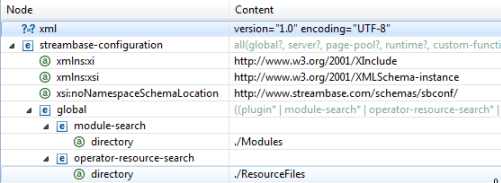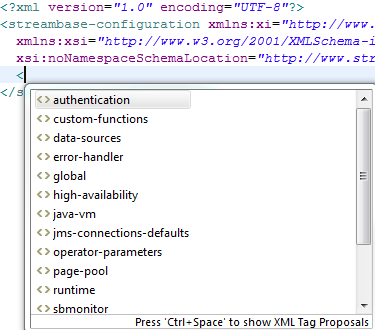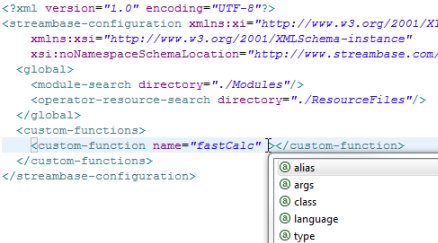The Server Configuration File Editor is a validating XML editor that is aware of the schema that defines the XML syntax of server configuration files. Take advantage of the following features while editing your deployment files:
- Typechecking Support
-
The Editor typechecks your configuration file as you compose or edit it. The Editor places a red X (
 ) marker on the left margin next to lines that fail to pass, and places a red location marker in the scroll bar. Hover the
mouse over the red X icon on the left or the location marker on the right to see a text message explaining the error detected.
) marker on the left margin next to lines that fail to pass, and places a red location marker in the scroll bar. Hover the
mouse over the red X icon on the left or the location marker on the right to see a text message explaining the error detected.
- Namespace Aware
-
The Editor is aware of XML namespaces. When you create a new configuration file, Studio places three namespace declarations in the top-level
<streambase-configuration>element. These declarations are what direct the Editor to Studio's internal copy of the configuration file schema. Do not edit or remove the namespace declarations, or Studio may not be able to provide schema-aware assistance while editing. - Source View
-
By default, Studio opens configuration files in the Source tab of the Editor, which shows the XML text of the file.
- Design View
-
You may prefer to use the Design View of the Editor, which shows the XML in a tree view. Content assistance, typechecking, and the other features of the Editor are still available in Design view. To enter Design view, select the Design tab at the bottom left of the Editor view; select Source to return to the default Source view.

- Syntax Color Coding
-
In Source view, the Editor provides syntax color coding of the XML text.
- Autocompletion
-
When typing a new element or attribute name, press Ctrl+Space after the first few letters. The Editor shows its content assistance window with one or more candidates to complete the element. If there is one candidate, press Enter to complete the element. Notice that the Editor inserts a closing tag for the element as well.

- Tag Proposal of Elements
-
Type an opening angle bracket, then Ctrl+Space. The Editor's content assistance window shows you all elements that are valid to enter in the current location.

In StreamBase releases that support Smart Merge XInclude Rules, the list of first-level elements includes the root element,
<streambase-configuration>. This element is in the list to support the inclusion of one configuration file into another, including the root element of the included file. When editing a configuration file for yourself, you do not normally ever include one<streambase-configuration>inside another<streambase-configuration>. See Using StreamBase Smart Merge Inclusion Rules for details. - Tag Proposal of Attributes
-
Place the cursor after an element name but before its closing angle bracket, then press Ctrl+Space. The Editor proposes all attributes that are valid for the current element and location.

- Valid URIs Become Active Hyperlinks
-
Any valid URI entered as part of a server configuration file, including the namespace declarations at the top of the file, are treated as active hyperlinks by Studio. You can click to open the resource referenced by the URI.
TIBCO encourages using the Configuration File Editor in Studio to edit all server configuration files, including fragment files that will be included in a top-level configuration file. If you use a different editor, be sure to load the resulting file at least once into Studio's Configuration File Editor so that your edits can be confirmed as valid.
Note
TIBCO discourages editing a project's server configuration file, or one of its component fragment files, in another editor outside of Studio while Studio is running. Nevertheless, if you do so, you must perform the following steps in this order:
-
Refresh the Studio project after such external edits. That is, select the project in the Package Explorer view, right-click, and select from the context menu (or select the project and press F5).
-
Refresh the project's typecheck environment. That is, select the project in the Package Explorer view, right-click, and select → from the context menu (or select the project and press Ctrl+F5).
